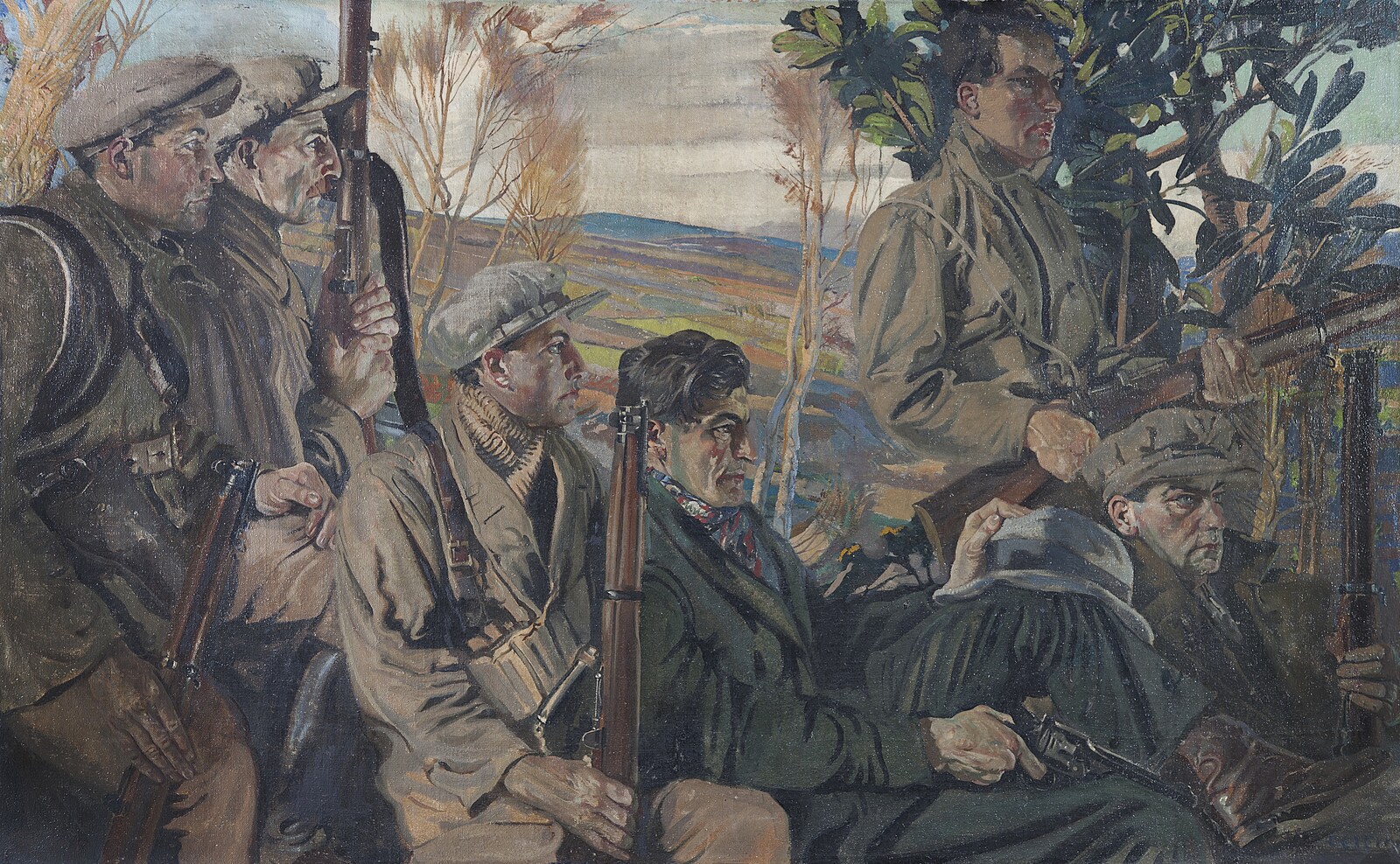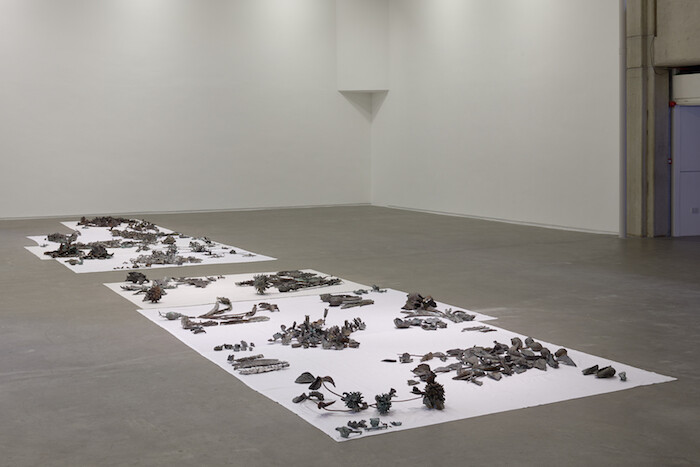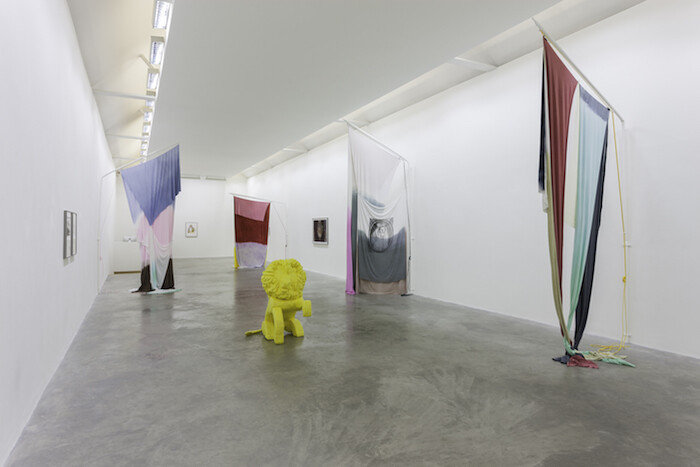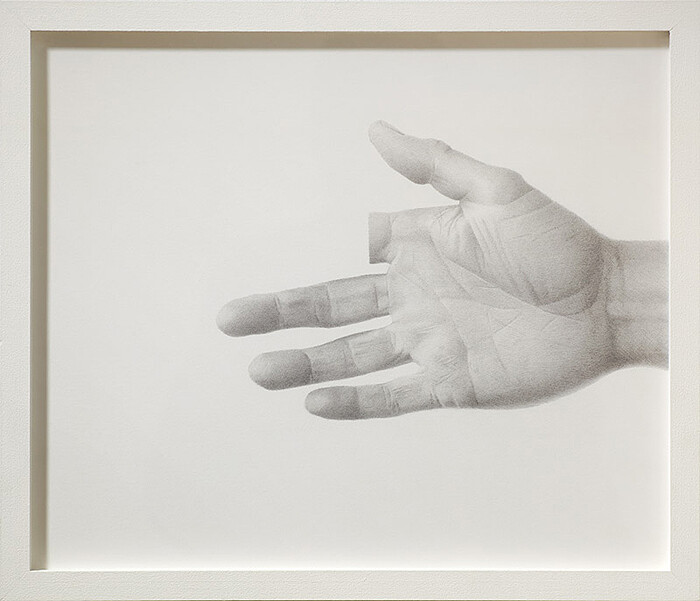Categories
Subjects
Authors
Artists
Venues
Locations
Calendar
Filter
Done
January 22, 2024 – Review
“Self-Determination: A Global Perspective”
Judith Wilkinson

“Everyone has the right to a nationality,” states article 15 of the “Universal Declaration of Human Rights” (1948) and “no one shall be deprived of his nationality nor denied the right to change his nationality.” As part of “Self-Determination: A Global Perspective,” Banu Çennetoğlu has filled the Irish Museum of Modern Art’s East Wing Gallery with three gigantic bouquets of gold helium letter balloons. Each bouquet, a mass of oversized jumbled letters, spells out a different article from the declaration. Throughout the course of the exhibition the balloons that make up right? (2022–ongoing) will deflate, lowering to the ground, until nothing remains but their empty carcasses.
An initiative of Annie Fletcher, IMMA’s director since 2019, “Self-Determination” explores the establishment of new post-World War I nation-states—including Finland, Estonia, Latvia, Poland, Ukraine, Turkey, Egypt, and Ireland itself—focusing on the role that art and artists played in statecraft and the formation of the national imagination. The site of the exhibition, the Royal Hospital Kilmainham (built in 1684 as a home for retired British soldiers), holds significance in the construction of the Irish nation. It was considered as a potential headquarters for Oíreachtas Shaorstát Éireann, the newly established government of the Irish Free State …
March 25, 2020 – Review
Gabriel Kuri’s “spending static to save gas”
Ben Eastham

Gabriel Kuri’s focus on the everyday exchanges that structure our social lives has, in the context of mass confinement, taken on a melancholy aspect. Insulated from the outside world by a PVC strip curtain, a spiral staircase leads visitors down to the Douglas Hyde’s cavernous lower gallery, its volume halved by a makeshift plastic ceiling suspended by thin wires from the rafters. The surface of this translucent canopy is speckled with dead gypsy moths, verdigrised coins, and crumpled cigarette butts arranged into neat grids. Seen from below, they resemble a constellation of exhausted stars or the beads on an abacus designed to calculate some inscrutable and unpayable debt.
The exhibition literature casually describes this dropped ceiling as establishing a “static field,” which at least sheds some light on its gnomic title: by reducing the space to be heated in the gallery, the installation conserves energy. Further consultation with an encyclopedia—and its tentatively grasped definition of a “static field” as something like the programming equivalent of a grammatical modifier—suggests that we might interpret the installation’s various elements as constituting a network of relations. The meaning of these materials is determined by the systems in which they participate, much as …
November 30, 2017 – Review
Dublin Gallery Weekend
Ben Eastham

Dublin is a dirty and disjointed city, a tangle of loosely connected neighborhoods best navigated on foot. On arrival my smartphone gave up the ghost, transforming the schedule of Dublin Gallery Weekend—a semi-coordinated program of exhibition openings, performances, and events—into a Situationist strategy. Deprived of online mapping services, I was forced to plot unusual paths between galleries across the city using a frayed, decade-old mental map. The resulting three-day drift along canal towpaths, through post-industrial edgelands, and down streets named for poets made it impossible to disentangle the experience of art from the emotional disorientation of travelling through the city hosting it.
Douglas Hyde Gallery is located at the bottom of Nassau Street, where students from Trinity College mingle with bookish tourists and frazzled shoppers. Abbas Akhavan’s “variations on a garden” seems initially to offer an oasis from the Black Friday bustle, the silence in the space interrupted only by the meditative drip of water into a shallow pool. That impression of sanctuary is reinforced, and then shattered, by an arrangement of bronze leaves, palm fronds, and flower stems (Study for a Monument, 2013-2016) arranged on the floor of the downstairs gallery. From the balcony, the sculptural installation resembles a set …
February 26, 2016 – Review
Siera Hyte’s “The Sometimes Hour” and Michael Ross’s “Selected Works 1991–2015”
Isobel Harbison

Siera Hyte’s “The Sometimes Hour”—an installation of carefully corroded objects and scratched or tampered images at Ellis King gallery, Dublin—has the air of a murder mystery. Hyte’s is one of two solo exhibitions running simultaneously in the space, the other a retrospective of the American artist Michael Ross, whose confounding matchbox-sized reliefs made from found armatures, plastics, screws, fabrics, and other seemingly symbolic material hang, evenly paced, on the wall. It is difficult to see a formal connection between the two artists, but the slow, up-close scrutiny commanded by Ross’s tiny intrigues carries over into a close inspection of each of Hyte’s component works.
Hyte’s bright, airy space is set up like a film set or crime scene. Objects perch on shelves (Fear of a stranger II, all works 2016) or sit on the floor, with other two-dimensional elements hanging framed, plastered, or pinned to the wall. The objects include vintage perfume bottles, each one a different color and pattern of cut glass, some with atomizers bound in diversely colored tassels. This dispersed collection would seem glamorous to the point of kitsch were it not for their curious surface covering of salt flakes. Hyte has distilled salt water so that its …
May 12, 2015 – Review
Isabel Nolan’s “Bent Knees are a Give”
Isobel Harbison

From bended knee comes Isabel Nolan’s most recent body of work. At Dublin’s Kerlin Gallery, this position between seating and standing is suggested in various depictions of John Donne, Lucretia, and Saint Jerome, in a polystyrene sculpture of a seated lion, and in a series of flags hung from bent poles. The temporary bend in this flexible joint symbolizes a lapse in the exertion of power: how the firm posture of the powerful upright might be weakened, caught in a moment of distraction, or kicked forward surreptitiously from behind.
For ever and ever, and infinite and super infinite for evers (all works 2015), a large framed archival pigment print, depicts Donne’s knees in his marble funereal sculpture located in London’s St Paul’s Cathedral, where the poet acted as dean for the final ten years of his life. The fabric of his robe is draped in waves but runs smoothly over his knees, a slight chink in the otherwise robust stance of this reputable seventeenth-century scholar and cleric. Posing for this marble statue in the final stages of his stomach cancer, several months before his death in 1631, Donne’s bent knee evidences to Nolan an interesting moment of distraction—apprehension, perhaps—for the metaphysical …
October 4, 2011 – Review
Tom Molloy’s "Doubt"
Aoife Rosenmeyer

Tom Molloy has been making pencil drawings for years, whose subjects are taken from photographs in the newspapers, pornography or official pictures of Texans executed under the death penalty. His style is painstakingly photorealist, though he refrains from the luxurious darkness of B pencils, keeping the images light and impassive, crosshatching rather than letting lines be loose and expressive. He smudges their edges in an abrasive act—perhaps to engender some dissonance in the reception of the overly-familiar images.
In this show at the Rubicon Gallery, however, his drawings are largely absent. The startling image on the invitation entitled Doubt (2010)—a meticulously drawn outstretched hand with its index finger weirdly truncated—is mysteriously missing from the exhibition. The image undoubtedly references Doubting Thomas’s need to put his finger in the wound of Jesus, in an act which sounds only pragmatic, but which, in the biblical context, accounts for his lack of faith. Molloy’s employment of the image, however, also suggests missing evidence, as if his finger had been excised: we are left with a dumb question and perhaps a joke at our expense.
Instead of traditional drawings, the gallery is dominated by Subplot (2008), a work seen earlier in the year at the Sharjah …